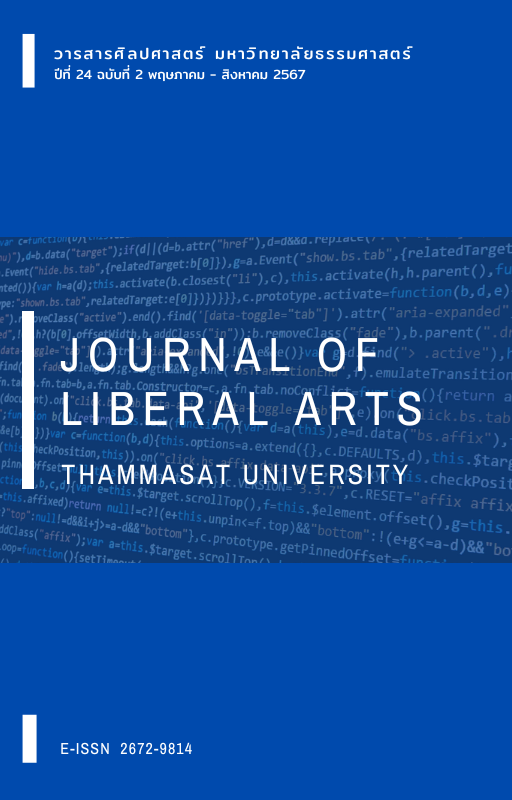แบบจำลองการเรียนรู้เครื่องแบบกลุ่มสำหรับประเมินความอ่อนไหวต่อการเกิดดินถล่มในจังหวัดอุตรดิตถ์ ประเทศไทย
Main Article Content
บทคัดย่อ
งานวิจัยนี้มีวัตถุประสงค์เพื่อเปรียบเทียบประสิทธิภาพการเรียนรู้เครื่องแบบกลุ่ม (ensemble learning) ด้วยอัลกอริทึม boosting สามแบบ ได้แก่ adaptive boosting (ADA) gradient boosting (GB) และ eXtreme gradient boosting (XGB) เพื่อหาแบบจำลองที่มีความเหมาะสมในการประเมินความอ่อนไหวของการเกิดดินถล่มในจังหวัดอุตรดิตถ์ โดยใช้ข้อมูลจุดเกิดและไม่เกิดดินถล่มที่ถูกบันทึกไว้ย้อนหลัง 30 ปี ในการฝึกสอนและทดสอบประสิทธิภาพของแบบจำลอง ใช้ข้อมูล 14 ประเภท ในการวิเคราะห์ปัจจัยที่ส่งผลต่อความอ่อนไหวในการเกิดดินถล่ม ประกอบไปด้วยปัจจัยทางธรรมชาติและปัจจัยที่ได้รับอิทธิพลจากมนุษย์ ทั้งนี้ เพื่อลดอิทธิพลจากความสัมพันธ์กันเองของตัวแปรอิสระ งานวิจัยนี้ได้ทดสอบ multicollinearity โดยกำหนดเกณฑ์ค่า VIF น้อยกว่า 5 และค่า TOL มากกว่า 0.10 มีปัจจัยที่ผ่านการคัดเลือกเข้าสู่แบบจำลอง 9 ปัจจัย และประสิทธิภาพของแบบจำลองจะถูกทดสอบด้วยค่าสถิติเพื่อให้ได้แบบจำลองที่ดีที่สุด ผลการศึกษาพบว่า 1) ปัจจัยด้านธรณีวิทยามีความสำคัญของปัจจัยสูงสุดในทุกแบบจำลอง 2) ทั้งสามแบบจำลองสามารถใช้ประเมินความอ่อนไหวต่อการเกิดดินถล่มได้ โดยแบบจำลอง GB และ XBG มีประสิทธิภาพสูงที่สุด เมื่อทดสอบด้วยค่าสถิติ F1-score และค่าความถูกต้องโดยรวม ส่วนการเปรียบเทียบพื้นที่ใต้กราฟ ROC แบบจำลอง XGB มีประสิทธิภาพสูงที่สุด 3) การทำนายการกระจายตัวของพื้นที่อ่อนไหวต่อดินถล่มของทั้งสามแบบจำลองมีความคล้ายคลึงกันบริเวณที่มีระดับความอ่อนไหวมากที่สุด ยกเว้นแบบจำลอง ADA ที่มีการแบ่งช่วงในระดับปานกลางถึงน้อยละเอียดกว่าแบบจำลองอื่น ๆ จากข้อค้นพบในครั้งนี้สามารถใช้เป็นเครื่องมือที่มีศักยภาพสำหรับการทำนายและใช้เป็นแนวทางในการลดความเสี่ยงจากภัยพิบัติได้
Downloads
Article Details

อนุญาตภายใต้เงื่อนไข Creative Commons Attribution-NonCommercial-NoDerivatives 4.0 International License.
เอกสารอ้างอิง
กรมทรัพยากรธรณี. (2551). ธรณีวิทยาของจังหวัดอุตรดิตถ์. จังหวัดอุตรดิตถ์ http://www.uttaradit.go.th
กรมอุตุนิยมวิทยา. (2566). ภูมิอากาศจังหวัดอุตรดิตถ์. ศูนย์ภูมิอากาศกรมอุตุนิยมวิทยา. http://climate.tmd.go.th/data/province/เหนือ/ภูมิอากาศอุตรดิตถ์.pdf
Akinci, H., Kilicoglu, C., & Dogan, S. (2020). Random forest-based landslide susceptibility mapping in coastal regions of Artvin, Turkey. ISPRS International Journal of Geo-Information, 9(9), 553. https://doi.org/10.3390/ijgi9090553
Akgun, A. (2012). A comparison of landslide susceptibility maps produced by logistic regression, multi-criteria decision, and likelihood ratio methods: a case study at zmir, Turkey. Landslides, 9(1), 93-106.
Alizadeh, M., Hashim, M., Alizadeh, E., Shahabi, H., Karami, M., Beiranvand Pour, A., Pradhan, B., & Zabihi, H. (2018). Multi-criteria decision making (MCDM) model for seismic vulnerability assessment (SVA) of urban residential buildings. ISPRS International Journal of Geo-Information, 7(11), 444. https://doi.org/10.3390/ijgi7110444
Aydin, H. E., & Iban, M. C. (2023). Predicting and analyzing flood susceptibility using boosting-based ensemble machine learning algorithms with SHapley Additive exPlanations. Natural Hazards, 116(1), 2957-2991. https://doi.org/10.1007/s11069-022-05793-y
Bui, D. T., Lofman, O., Revhaug, I., & Dick, O. (2011). Landslide susceptibility analysis in the Hoa Binh province of Vietnam using statistical index and logistic regression. Natural hazards, 59(3), 1413-1444. https://doi.org/10.1007/s11069-011-9844-2
Choi, J., Oh, H.-J., Lee, H.-J., Lee, C., & Lee, S. (2012). Combining landslide susceptibility maps obtained from frequency ratio, logistic regression, and artificial neural network models using ASTER images and GIS. Engineering Geology, 124, 12-23. https://doi.org/10.1016/j.enggeo.2011.09.011
Guzzetti, F., Cardinali, M., Reichenbach, P., Cipolla, F., Sebastiani, C., Galli, M., & Salvati, P. (2004). Landslide hazard assessment in the Collazzone area, Umbria, Central Italy. Natural Hazards and Earth System Sciences, 4(1), 1-15. https://doi.org/10.5194/nhess-4-1-2004
Keefer, D. K. (1984). Landslides caused by earthquakes. Geological Society of America Bulletin, 95(4), 406-421.
Reichenbach, P., Rossi, M., Malamud, B. D., Mihir, M., & Guzzetti, F. (2018). A review of statistically based landslide susceptibility models. Earth-science reviews, 180, 60-91.
Regmi, A. D., Devkota, K. C., Yoshida, K., & Pourghasemi, H. R. (2014). Application of frequency ratio, statistical index, and weights-of-evidence models and their comparison in landslide susceptibility mapping in Central Nepal Himalaya. Arabian Journal of Geosciences, 7, 725–742. https://doi.org/10.1007/s12517-012-0807-z
Rong, G., Alu, S., Li, K., Su, Y., Zhang, J., Zhang, Y., & Li, T. (2020). Rainfall induced landslide susceptibility mapping based on Bayesian optimized random forest and gradient boosting decision tree models—A case study of Shuicheng County, China. Water, 12(11), 3066. https://doi.org/10.3390/w12113066
Sokolova, M., Japkowicz, N., & Szpakowicz, S. (2006). Beyond accuracy, F-score and ROC: A family of discriminant measures for performance evaluation. In A. Sattar, & B. H. Kang (Eds.), AI 2006: Advances in Artificial Intelligence (pp. 1015-1021). Springer. https://doi.org/10.1007/11941439_114
Inan, M. S. K., & Rahman, I. (2023). Explainable AI integrated feature selection for landslide susceptibility mapping using Tree SHAP. SN Computer Science, 4, 482. https://doi.org/10.1007/s42979-023-01960-5
Intarat, K., Yoomee, P., Hussadin, A., & Lamprom, W. (2024). Assessment of landslide susceptibility in the intermontane basin area of Northern Thailand. Environment and Natural Resources Journal, 22(2), 158-170. https://doi.org/10.32526/ennrj/22/20230241
Halder, K., Srivastava, A. K., Ghosh, A., Das, S., Banerjee, S., Pal, S. C., Chatterjee, U., Bisai, D., Ewert, F., & Gaiser, T. (2024). Improving landslide susceptibility prediction through ensemble Recursive Feature Elimination and meta-learning framework. Research Square. Advance online publication. https://doi.org/10.21203/rs.3.rs-3991474/v1
Huan, Y., Song, L., Khan, U., & Zhang, B. (2023). Stacking ensemble of machine learning methods for landslide susceptibility mapping in Zhangjiajie City, Hunan Province, China. Environmental Earth Sciences, 82(1), Article 35. https://doi.org/10.1007/s12665-022-10413-1
Hydro-Informatics Institute. (n.d.). North flood situation in May 2006. Retrieved May 06, 2024, from https://tiwrm.hii.or.th/current/FloodNorth_May49.html
Trigila, A., Frattini, P., Casagli, N., Catani, F., Crosta, G., Esposito, C., Ladanza, C., Lagomarsino, D., Mugnozza, G. S., Segoni, S., Spizzichino, D., Tofani, V., & Lari, S. (2013). Landslide susceptibility mapping at national scale: The Italian case study. In C. Margottini, P. Canuti, & K, Sassa (Eds.), Landslide science and practice (pp. 287-295). Springer.
Park, S., Choi, C., Kim, B., & Kim, J. (2013). Landslide susceptibility mapping using frequency ratio, analytic hierarchy process, logistic regression and artificial neural network methods at the Inje area, Korea. Environmental Earth Sciences, 68, 1443-1464. https://doi.org/10.1007/s12665-012-1842-5
Pham, B. T., Pradhan, B., Bui, D. T., Prakash, I., & Dholakia, M. (2016). A comparative study of different machine learning methods for landslide susceptibility assessment: A case study of Uttarakhand area (India). Environmental Modelling & Software, 84, 240-250. https://doi.org/10.1016/j.envsoft.2016.06.019
Freund, Y., & Schapire, R. E. (1997). A decision-theoretic generalization of on-line learning and an application to boosting. Journal of computer and system sciences, 55(1), 119-139.
Jennifer, J. J. (2022). Feature elimination and comparison of machine learning algorithms in landslide susceptibility mapping. Environmental Earth Sciences, 81, 489. https://doi.org/10.1007/s12665-022-10620-5
Muschelli, J. (2020). ROC and AUC with a binary predictor: A potentially misleading metric. Journal of Classification, 37(3), 696-708. https://doi.org/10.1007/s00357-019-09345-1
Wu, Y., Ke, Y., Chen, Z., Liang, S., Zhao, H., & Hong, H. (2020). Application of alternating decision tree with AdaBoost and bagging ensembles for landslide susceptibility mapping. CATENA, 187, 104396. https://doi.org/10.1016/j.catena.2019.104396
Yu, H., Pei, W., Zhang, J., & Chen, G. (2023). Landslide susceptibility mapping and driving mechanisms in a vulnerable region based on multiple machine learning models. Remote Sensing, 15(7), 1886. https://doi.org/10.3390/rs15071886
Yu, X., Zhang, K., Song, Y., Jiang, W., & Zhou, J. (2021). Study on landslide susceptibility mapping based on rock-soil characteristic factors. Scientific Reports, 11(1), 15476. https://doi.org/10.1038/s41598-021-94936-5
Yalcin, A. (2008). GIS-based landslide susceptibility mapping using analytical hierarchy process and bivariate statistics in Ardesen (Turkey): Comparisons of results and confirmations. CATENA, 72(1), 1-12. https://doi.org/10.1016/j.catena.2007.01.003


